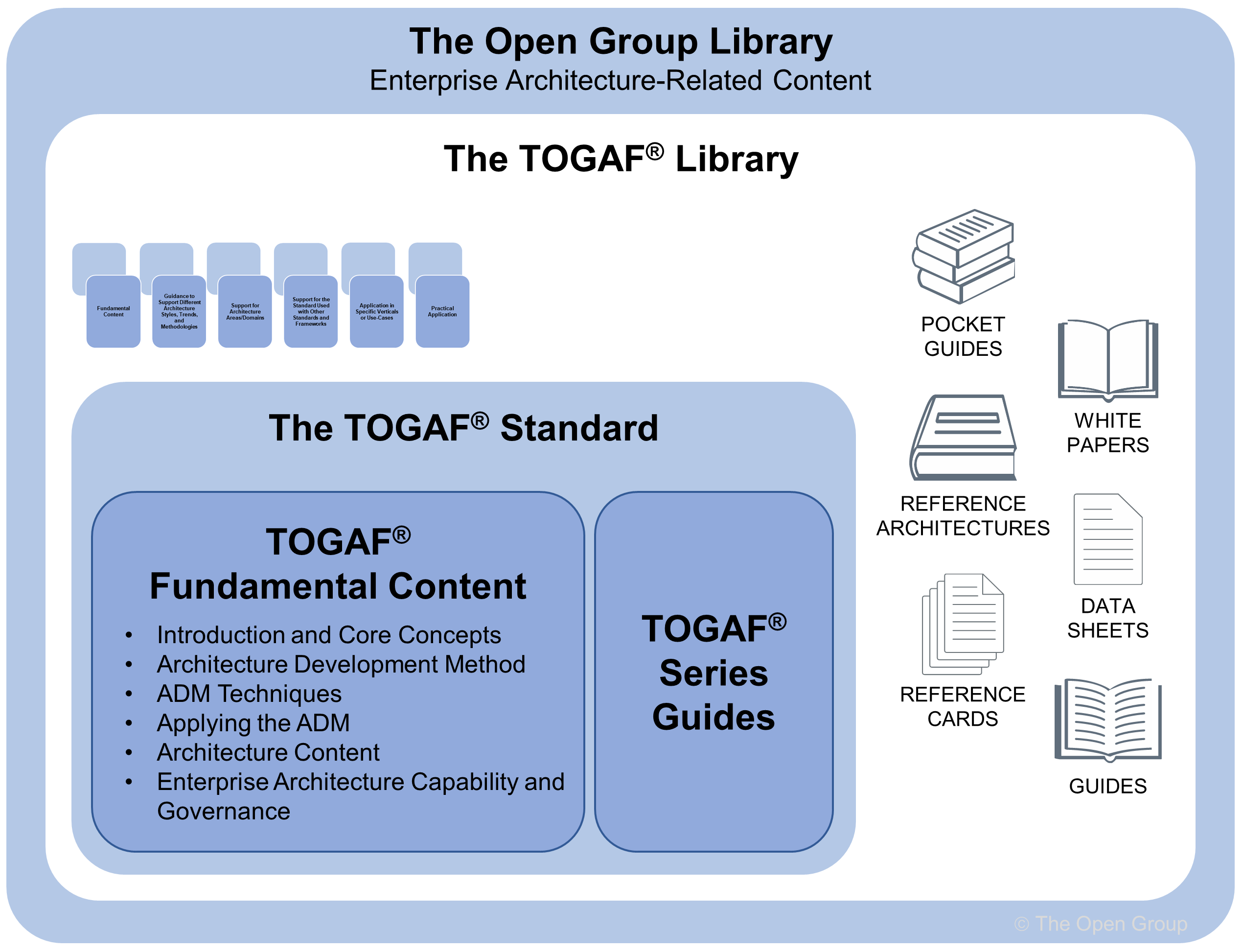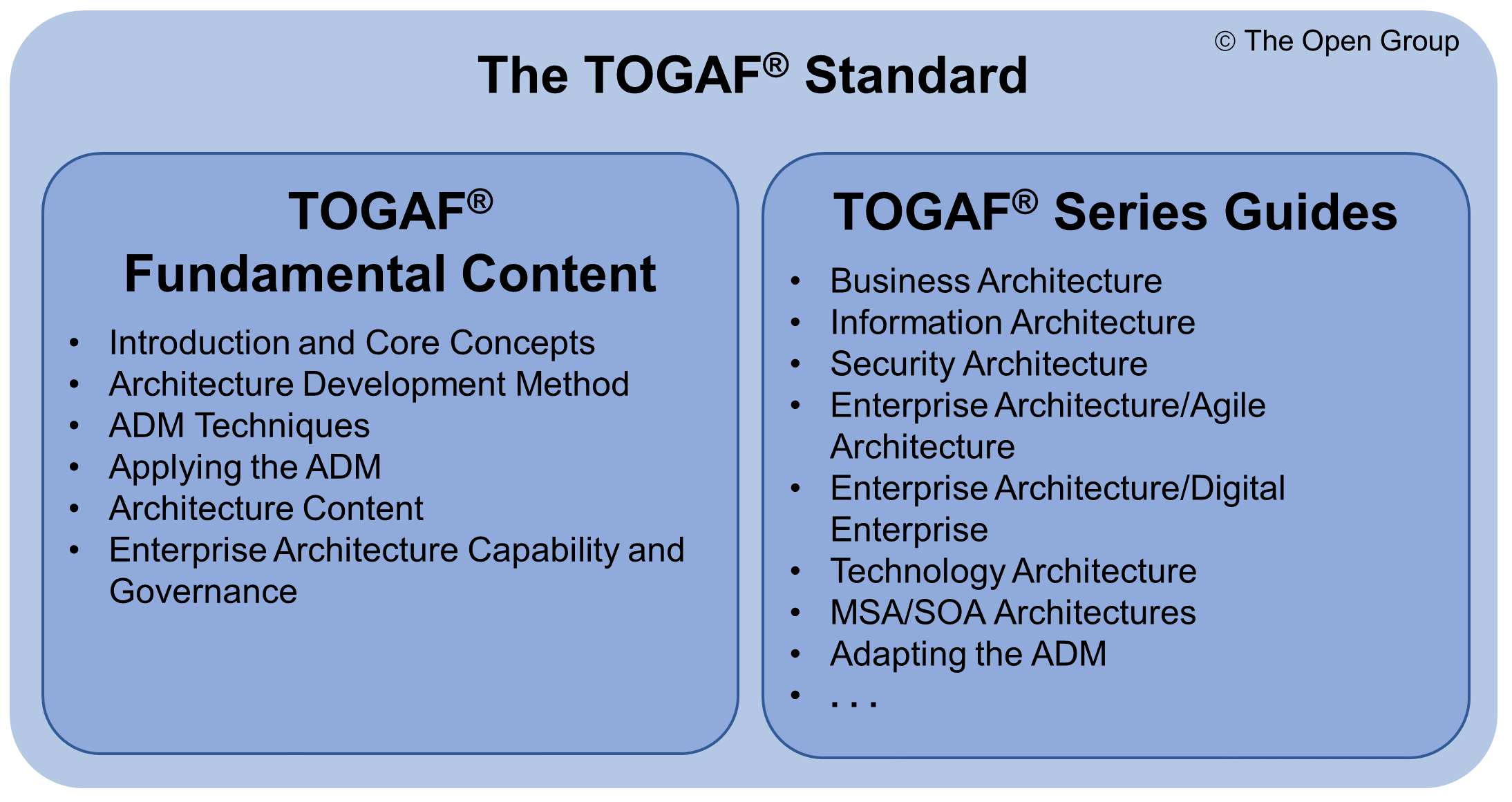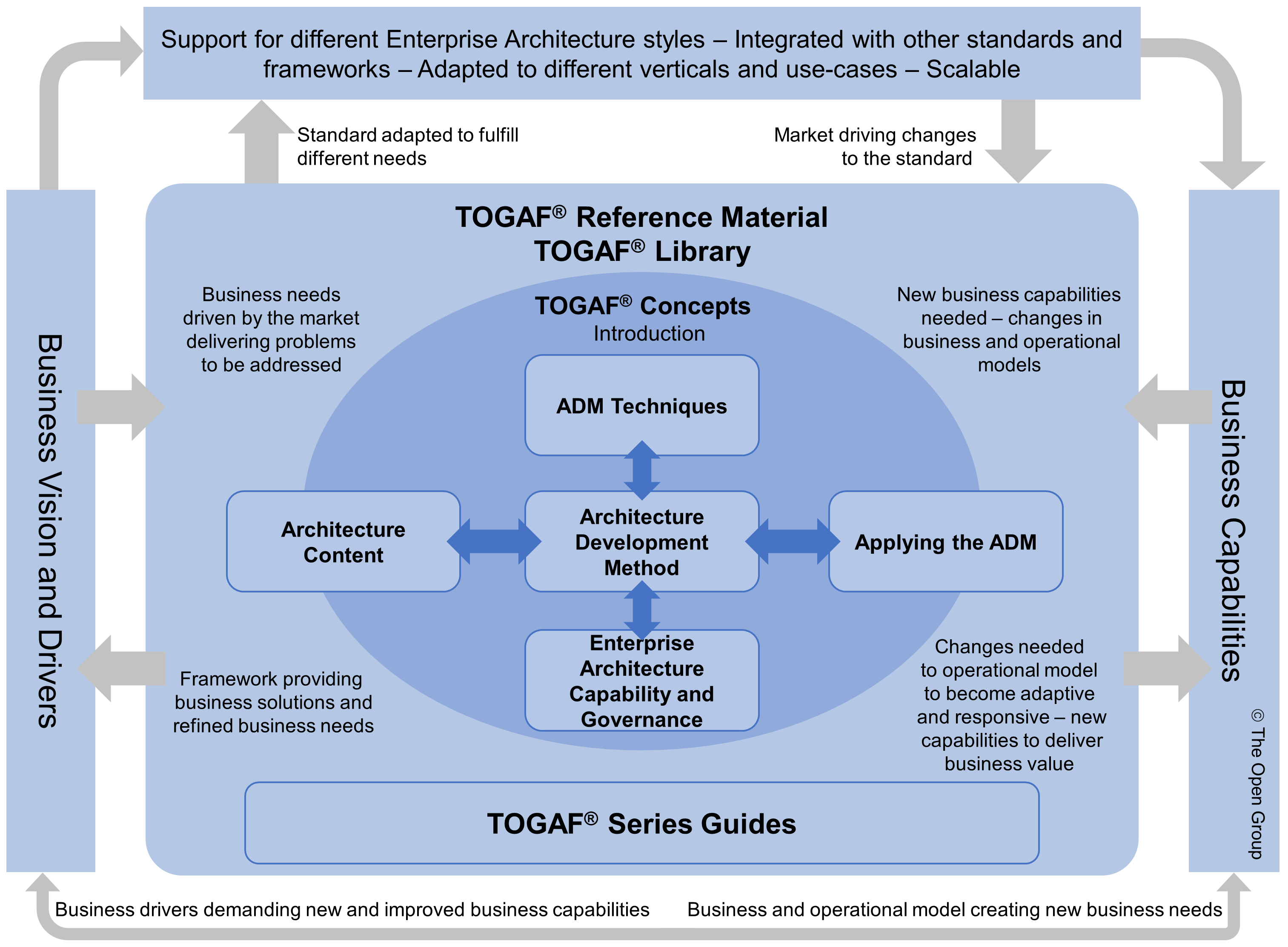Introduction
This chapter provides an introduction to the TOGAF® Standard, an open, industry consensus framework for Enterprise Architecture.
Topics addressed in this chapter include:
-
An introduction to the TOGAF Standard
-
The structure and content of the TOGAF documentation
-
An overview of the TOGAF Standard
-
The TOGAF Library
-
An overview of the TOGAF framework
-
How to read the standard
Introduction to the TOGAF Standard
The TOGAF Standard is a framework for Enterprise Architecture. Put simply, it is a standard approach for developing, approving, using, and maintaining Enterprise Architectures. It applies to all Enterprise Architecture practices. It is based on an iterative process model supported by best practices and a re-usable set of existing architectural assets.
The TOGAF Standard ![]() is developed and maintained by members of The Open Group, working within the Architecture Forum. The original development of the TOGAF Standard, Version 1 in 1995 was based on the US Department of Defense Technical Architecture Framework for Information Management (TAFIM). Starting from this sound foundation, The Open Group Architecture Forum has developed successive versions of the TOGAF Standard at regular intervals and published each one on The Open Group public website. Successive versions have represented the current state of stable, scalable, best practice.
is developed and maintained by members of The Open Group, working within the Architecture Forum. The original development of the TOGAF Standard, Version 1 in 1995 was based on the US Department of Defense Technical Architecture Framework for Information Management (TAFIM). Starting from this sound foundation, The Open Group Architecture Forum has developed successive versions of the TOGAF Standard at regular intervals and published each one on The Open Group public website. Successive versions have represented the current state of stable, scalable, best practice.
This version builds on previous versions of the TOGAF Standard, expanding and updating the material available to architecture practitioners to assist them in building a sustainable Enterprise Architecture.
Structure of the TOGAF Documentation
The TOGAF documentation set is structured to address the transition from common universal concepts to the unique configuration within an organization. It includes the formal TOGAF Standard and a broader body of knowledge in the TOGAF Library ![]() , as shown in Figure 1.
, as shown in Figure 1.
The TOGAF Standard represents today’s stable, scalable, best practices, with concepts and guidance that apply across industries, scale, and pace of change. This is expected from a standard – proven practices, stable concepts, and being actionable. The TOGAF Standard provides a body of proven practices addressing its broad uses. The TOGAF Fundamental Content includes the universal concepts of Enterprise Architecture. The TOGAF Series Guides take these concepts and make them actionable. Together, the TOGAF Fundamental Content and the TOGAF Series Guides are the TOGAF Standard.

The intent of dividing the TOGAF Standard into these separate documents is to allow for different areas of specialization to be considered in detail and potentially addressed in isolation. Although all the constituent documents work together as a whole, it is also feasible to select particular documents for adoption while excluding others.
The TOGAF documentation set structure is modular. There is a clear hierarchy from the universal concepts in the TOGAF Fundamental Content, to the stable best practices in the TOGAF Series Guides, to emerging ideas in the TOGAF Library. The structure of the TOGAF documentation set makes the adoption of your optimal method easier.
An Overview of the TOGAF Standard

The TOGAF Standard applies to all Enterprise Architecture practices. It does not matter whether your architecture will support strategy, portfolio, project, or solution delivery, or whether it is about embarking on a Digital Transformation or legacy simplification. The TOGAF Fundamental Content and TOGAF Series Guides provide enduring, stable, universal concepts, and proven best practices.
The TOGAF Fundamental Content
The TOGAF Fundamental Content consists of six documents as shown in Table 1. Central to the TOGAF Fundamental Content is the TOGAF Architecture Development Method (ADM), which provides a tested and repeatable process for developing architectures.
| Document | Summary |
|---|---|
This document introduces the TOGAF Standard. It provides an executive overview of Enterprise Architecture and the TOGAF Standard; it describes the structure of the TOGAF documentation set, the core concepts of the framework, together with terminology and definitions that apply to the Fundamental Content. |
|
This document describes the TOGAF ADM, which is an iterative approach to developing an Enterprise Architecture. |
|
This document contains a collection of techniques available for applying the TOGAF approach and the TOGAF ADM. |
|
This document contains guidelines for adapting the TOGAF ADM to address the specific style of architecture required in a practical context. |
|
This document describes the TOGAF Content Framework, a structured metamodel for architectural artifacts, and an overview of typical architecture deliverables. |
|
The TOGAF Standard: Enterprise Architecture Capability and Governance |
This document describes the organization, processes, skills, roles, and responsibilities required to establish and operate an architecture function within an enterprise and describes an Enterprise Architecture governance framework. |
The role of the TOGAF Fundamental Content is to provide essential concepts and established best practices that are stable and enduring. The concepts in the TOGAF Fundamental Content are considered to be universally applicable to the TOGAF framework.
Visit the TOGAF Standard Digital Edition ![]()
The TOGAF Series Guides
The TOGAF Series Guides consist of a series of best practice documents, that is expected to expand over time as the professional body of knowledge that forms the TOGAF Standard expands with more stable best practice.
The role of the TOGAF Series Guides is to build upon the content provided in the TOGAF Fundamental Content by providing extended guidance for specific topics, concerns, and use-cases. Examples of the topic areas covered by this guidance material are shown in Figure 2.
Documentation Set Summary
At the time of writing, the TOGAF Standard documentation set is summarized in Table 3. The general categories for document type can be considered as:
This categorization is also used to organize the chapter content within this document.
| Domain-Specific Guidance | |
|---|---|
SA = Security Architecture |
BA = Business Architecture |
IA = Data/Information Architecture |
AM = Agile Methods |
RM = Reference Models and Method |
|
| Document | General How-To | Establishing an EA Team | SA | BA | IA | AM | RM | TOGAF Fundamental Content |
|---|---|---|---|---|---|---|---|---|
TOGAF Series Guide: A Practitioners’ Approach to Developing Enterprise Architecture Following the TOGAF ADM |
X |
|||||||
TOGAF Series Guide: Using the TOGAF Standard in the Digital Enterprise |
X |
|||||||
TOGAF Series Guide: Digital Technology Adoption: A Guide to Readiness Assessment and Roadmap Development |
X |
|||||||
TOGAF Series Guide: The TOGAF Leader’s Guide to Establishing and Evolving an EA Capability |
X |
|||||||
TOGAF Series Guide: Integrating Risk and Security within a TOGAF Enterprise Architecture |
X |
|||||||
TOGAF Series Guide: Business Models |
X |
|||||||
TOGAF Series Guide: Business Capabilities, Version 2 |
X |
|||||||
TOGAF Series Guide: Business Capability Planning |
X |
|||||||
TOGAF Series Guide: Value Streams |
X |
|||||||
TOGAF Series Guide: Information Mapping |
X |
|||||||
TOGAF Series Guide: Organization Mapping |
X |
|||||||
TOGAF Series Guide: Business Scenarios |
X |
|||||||
TOGAF Series Guide: Information Architecture: Customer Master Data Management (C-MDM) |
X |
|||||||
TOGAF Series Guide: Information Architecture: Metadata Management |
X |
|||||||
TOGAF Series Guide: Enabling Enterprise Agility |
X |
|||||||
TOGAF Series Guide: Applying the TOGAF ADM using Agile Sprints |
X |
|||||||
TOGAF Series Guide: TOGAF Digital Business Reference Model (DBRM) |
X |
X |
||||||
TOGAF Series Guide: Government Reference Model |
X |
X |
||||||
TOGAF Series Guide: Architecture Maturity Models |
X |
|||||||
TOGAF Series Guide: Architecture Project Management |
X |
|||||||
TOGAF Series Guide: Architecture Skills Framework |
X |
|||||||
The TOGAF Standard: Introduction and Core Concepts |
X |
|||||||
The TOGAF Standard: Architecture Development Method |
X |
|||||||
The TOGAF Standard: ADM Techniques |
X |
|||||||
The TOGAF Standard: Applying the ADM |
X |
|||||||
The TOGAF Standard: Architecture Content |
X |
|||||||
The TOGAF Standard: Enterprise Architecture Capability and Governance |
X |
The TOGAF Library
Accompanying the standard are additional resources contained in the TOGAF Library. Whereas the TOGAF Series Guides are proven, stable, best practices, the TOGAF Library also provides emerging ideas, guidelines, templates, patterns, and other forms of reference material to accelerate the creation of new architectures for the enterprise.
The TOGAF Library follows a categorization model based on capabilities and features, as shown in Figure 3.

It includes material developed elsewhere in The Open Group; for example, The Open Group IT4IT™ Reference Architecture, The Open Group Commercial Aviation Reference Architecture, and the O-PAS™ Standard. They are reference architectures developed by experts in their industry, and can be adopted or used as examples.
Emerging ideas in the TOGAF Library are often in the form of White Papers. Material in this category either has not yet stood the test of time, or the members developed the idea to a usable point and have moved their innovative thinking to a new idea.
All documents in the TOGAF Library can be used as-is or used as a start for developing your organization’s Enterprise Architecture.
Visit the TOGAF Library ![]()
An Overview of the TOGAF Framework
The TOGAF framework reflects the structure and content of an Architecture Capability within an enterprise, as shown in Figure 4.

Central to the framework is the Architecture Development Method. The Enterprise Architecture Capability and Governance operates the method. The method is supported by ADM Techniques, Applying the ADM guidelines, the TOGAF Series Guides, and the TOGAF Library. This produces content to be stored as Architecture Content.
How to Read the Standard
In this section, brief guidance is provided for readers approaching this version of the TOGAF Standard.
For readers approaching the topic of Enterprise Architecture for the first time, it is recommended to read the White Paper Why does Enterprise Architecture Matter? available from the TOGAF Library at https://www.opengroup.org/library/w076 ![]() .
.
For readers approaching the TOGAF Standard for the first time, it is recommended to read this document in conjunction with the TOGAF Standard – Introduction and Core Concepts (part of the Fundamental Content).
For all readers, including those familiar with earlier versions of the TOGAF Standard, it is recommended to read the White Paper An Introduction to the TOGAF Standard, 10th Edition available from the TOGAF Library at https://www.opengroup.org/library/w212 ![]() .
.
Audience-Specific Guidance
In the following section, we provide guidance for Enterprise Architects, Enterprise Architecture Team Leaders, and Sponsors of Enterprise Architecture Teams:
Guidance for Enterprise Architects
This approach is aimed at Enterprise Architects most concerned with developing an Enterprise Architecture for their organization. It moves directly to how to develop, approve, and use your Enterprise Architecture.
A good first step is to obtain a copy of the TOGAF Series Guide: A Practitioners’ Approach to Developing Enterprise Architecture Following the TOGAF ADM. Chapters 3 and 6 set the stage for applying everything in the TOGAF Standard, the TOGAF Fundamental Content, other TOGAF Series Guides, and the TOGAF Library.
A next step is to read the TOGAF Series Guide: Integrating Risk and Security within a TOGAF Enterprise Architecture. Risk and security are central to every Enterprise Architecture practitioner. Every practitioner has accountability to improve the performance of their organization. Practitioners are accountable for reducing the uncertainty of the organization reaching its objectives and improving its security.
Then obtain a copy of each guide that applies to your work. The guides are applicable because of the problem or domain they are designed to address. If your organization has digital initiatives, then get the digital-specific guides. If you need to enable Agile development, then get the Agile guides. If you are a Business Architect, then get the Business Architecture guides. If you are a Data Architect, then the TOGAF Series Guide: Information Architecture: Customer Master Data Management (C-MDM) may be helpful.
Lastly, explore the TOGAF Library. You will find documents that directly help you do your job or show you a very effective approach. Both make you a better Enterprise Architect. At every point, the TOGAF Fundamental Content is available to provide a consistent framework.
Guidance for Enterprise Architecture Team Leaders
Leaders have the challenge of optimizing their Enterprise Architecture Capability and developing their practitioners.
In this section we provide brief guidance for Enterprise Architecture team leaders on how to get started with this version of the TOGAF Standard.
Obtain a copy of the TOGAF Series Guide: The TOGAF Leader’s Guide to Establishing and Evolving an EA Capability. Ensure that you have clarity on the purpose of your Enterprise Architecture team (Section 3.3), and the boundary of your enterprise (Sections 4.1 and 4.2).
Identify any gaps in your ability to deliver the Enterprise Architecture your organization wants to consume. Consider how to address the gaps. You will likely find the following TOGAF Series Guides useful: Integrating Risk and Security within a TOGAF Enterprise Architecture and Using the TOGAF Standard in the Digital Enterprise. High-performing Enterprise Architecture teams always reduce the uncertainty of the organization reaching its objectives and improving its security. If your organization is not on a Digital Transformation journey, then you should expect it to start soon.
The next step is to obtain a copy of each guide that applies to your team. Become familiar with them and distribute them to your team.
Read the TOGAF Series Guide: The TOGAF® Leader’s Guide to Establishing and Evolving an EA Capability ![]()
Guidance for Sponsors of Enterprise Architecture Teams
Sponsors know they can improve their organization’s ability to make better change decisions and execute the changes with Enterprise Architecture. They will have championed their Enterprise Architecture team to help their organization. Most sponsors have the additional challenge of not being Enterprise Architecture practitioners, or Enterprise Architecture team leads. Most want the outcome without the need to understand the detail of how the work is done.
Read the TOGAF Series Guide: The TOGAF Leader’s Guide to Establishing and Evolving an EA Capability. You should provide clarity on the purpose of your Enterprise Architecture team (Sections 3.3 and 8.2), the boundary of your enterprise (Sections 4.1 and 4.2), and how success will be measured (Section 5.4). Further, you need to assist with the improvement of your governance structure (Chapter 6).